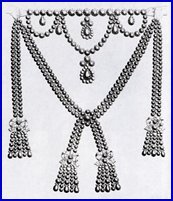
[Click
here for our story so far...]
The first Marie Antoinette knew of her "purchase" of the necklace was when the jewelers (most humbly and very,
very anxiously) sent her a dunning letter for the gigantic unpaid bill. Then, as they say, all Hell broke loose. The scandal became public; the Cardinal was denounced, and Jeanne was arrested along with just about everybody else who had ever as much as shaken hands with the Cardinal.
Acting against some very good advice, Marie Antoinette insisted on a trial for the Cardinal on the charge that he was guilty simply because he had believed that she was capable of having the sort of "relationship" with him he had thought she had. This, of course, played right into the hands of the Queen's numerous enemies who were only too happy to have publicly broadcast the exact nature of what the Cardinal had thought were the Queen's morals, or lack thereof.
There followed a sensational trial, which was ostensibly about the Cardinal's actions but was really about the Queen's reputation. Jeanne's lawyer was Maitre Doillot, a respected advocate who was in somewhat over his head in dealing with Jeanne. He was the family lawyer of the Paris Police Lieutenant General, and had been recommended to Jeanne by that worthy as a favor -for what we will not speculate, though many others did at the time. The Count Beugnot, himself a lawyer (and another one of Jeanne's former lovers) had turned down her plea that he defend her, and had this to say about Maitre Doillot-
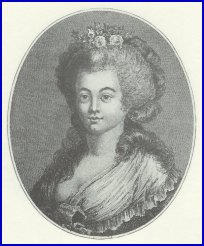 "Doillot had been in practice before the Paris bar for many, many years, and not without renown. Deep in his sixties or beyond, he had retired to his study, where he was still consulted as an eminent jurist. Even a sage old gentleman such as this could not with impunity survive close contact with the Countess de la Motte. She completely turned his head. He believed implicitly all the tales she spun him, became emotionally involved with his client and put up an impassioned defense of her innocence, making his debut in the case with the publication of a trial brief, the most extravagant defense plea ever to flow from the pen of an attorney in all the years since attorneys first began composing defense pleas. Fantastic as a tale out of 'The Arabian Nights', it enjoyed, nonetheless, a sensational success. And to think that it was the composition of a venerable white-wig of seventy summers!".
"Doillot had been in practice before the Paris bar for many, many years, and not without renown. Deep in his sixties or beyond, he had retired to his study, where he was still consulted as an eminent jurist. Even a sage old gentleman such as this could not with impunity survive close contact with the Countess de la Motte. She completely turned his head. He believed implicitly all the tales she spun him, became emotionally involved with his client and put up an impassioned defense of her innocence, making his debut in the case with the publication of a trial brief, the most extravagant defense plea ever to flow from the pen of an attorney in all the years since attorneys first began composing defense pleas. Fantastic as a tale out of 'The Arabian Nights', it enjoyed, nonetheless, a sensational success. And to think that it was the composition of a venerable white-wig of seventy summers!".The Abbe Georgel called Doillot's first plea "a tissue of lies, of striking improbabilities, contradictions and anachronisms". Doillot's own brother agreed-
"The man has either gone stark raving mad or Madame de la Motte has bewitched him as she did the Cardinal".After much scandal mongering in both the courtroom and the streets the Queen's enemies won and the Cardinal was acquitted. Others were not so lucky- the Count Cagliostro was exiled from France, and eventually returned to Italy where he was arrested and convicted on charges of practicing Freemasonry; he died in prison in 1795.
Jeanne was convicted and whipped, branded, and thrown into the Bastille at which point she may (or may not) have had a fling with its Governor, the poor Launay, who would lose his head at the hands of the mob when they stormed the ancient fortress a few months later.
Jeanne was now a favorite of the anti-Antoinette faction, which was growing quickly in France, and she was able to intrigue to escape the country and made her way, with her husband, to London.
Once there she immediately set out on a plan of revenge against the Queen which took the form of her famous "Memoires Justificatifs de la Comtesse de Valois de la Motte". These contained her own highly slanted version of her life and the Diamond Necklace Affair, as well as some thirty pieces of correspondence she claimed had passed between the Cardinal and the Queen.
"From the moment of my arrival in London," she wrote,
"my first and only thought had been publication of my justification for the eyes of all the world... I too would have preferred to spare the honour of the Queen, and I tried to warn her Majesty that I was in Possession of certain letters...incriminating her and exculpating me... All I asked in return was restitution of property rightfully mine which had been seized, after an iniquitous verdict, to enrich the coffers of the King. But I really never considered it likely that the French court would capitulate to those terms, and besides, my main goal was public vindication. To this purpose, then, I eagerly took up my pen, denying my feeble, tortured body even the minimal physical requirements of nourishment and sleep until my memoirs should be ready for publication. Although we were obliged to borrow money to defray the costs of printing, five thousand copies in French have now come off the press, and three thousand more in English; the latter went on sale at a guinea each in New Bond Street shops."The readers of England and France could not get enough of the Countess's memoirs, although what you thought of them depended on which side of the Royal table you sat on- "a cesspool of calumny" was the verdict of the Abbe Georgel, friend and secretary of Cardinal Rohan. In October of 1789 a "Second Memoirs justicatif", much more barbed and venomous than the first, was rushed to the printers, another direct attack on the Queen by Jeanne, published in French and English and distributed in Paris where it stirred the mobs to a new frenzy.
Mirabeau said of the Countess- "Madame de La Motte's voice alone brought on the horrors of July 14 and of October 5" (the storming of Versailles and the slaughter of the troops there by the 'Women's Army').
Her works spawned a storm of other pamphlets, each one trying to outdo the other in decrying the licentiousness and debauchery of the Queen. Frances Mossiker, in "The Queen's Necklace", notes, however, that's Jeanne's works were the most influential-
"There were other attacks perhaps more obscene, but they were published under noms de plume and therefore were never as pungent and convincing as those signed by a real-life name, a name famous, moreover, throughout Europe ever since the Necklace Trial".In 1791 the Countess's two volume "Story of My Life" came off the presses, but Jeanne would not live to enjoy its fruits. In early June the London newspapers reported that a London bailiff had appeared at her lodgings to serve an order for her mounting debts. Others said that the men were actually secret agents sent by the Duke of Orleans; that was what Jeanne believed, and to get away from them she barricaded herself in and then climbed out a third floor window, falling to the street below. Badly injured, she lingered in extreme pain through the hot weeks of July and into August, when, on August 23rd, 1791, she died. She was buried a few days later in the churchyard of St. Mary's, in Lambeth.
The Queen against whom Jeanne had intrigued for so long survived her by just two years, one month, and 23 days, before mounting the steps to the guillotine in Paris to the howling delight of the mob.
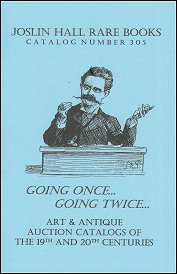 One of the things the book elves love about country life is going to country auctions. There just seems to be no end to the stuff we need that they find there (although I am thinking of returning the goat). But before the book elves wheeled into the yard last night with 3 boxes of Limoges soup bowls and a concrete birdbath in the shape of Mel Torme, they finished our latest catalog-
One of the things the book elves love about country life is going to country auctions. There just seems to be no end to the stuff we need that they find there (although I am thinking of returning the goat). But before the book elves wheeled into the yard last night with 3 boxes of Limoges soup bowls and a concrete birdbath in the shape of Mel Torme, they finished our latest catalog-
 [Click
[Click  "Doillot had been in practice before the Paris bar for many, many years, and not without renown. Deep in his sixties or beyond, he had retired to his study, where he was still consulted as an eminent jurist. Even a sage old gentleman such as this could not with impunity survive close contact with the Countess de la Motte. She completely turned his head. He believed implicitly all the tales she spun him, became emotionally involved with his client and put up an impassioned defense of her innocence, making his debut in the case with the publication of a trial brief, the most extravagant defense plea ever to flow from the pen of an attorney in all the years since attorneys first began composing defense pleas. Fantastic as a tale out of 'The Arabian Nights', it enjoyed, nonetheless, a sensational success. And to think that it was the composition of a venerable white-wig of seventy summers!".
"Doillot had been in practice before the Paris bar for many, many years, and not without renown. Deep in his sixties or beyond, he had retired to his study, where he was still consulted as an eminent jurist. Even a sage old gentleman such as this could not with impunity survive close contact with the Countess de la Motte. She completely turned his head. He believed implicitly all the tales she spun him, became emotionally involved with his client and put up an impassioned defense of her innocence, making his debut in the case with the publication of a trial brief, the most extravagant defense plea ever to flow from the pen of an attorney in all the years since attorneys first began composing defense pleas. Fantastic as a tale out of 'The Arabian Nights', it enjoyed, nonetheless, a sensational success. And to think that it was the composition of a venerable white-wig of seventy summers!".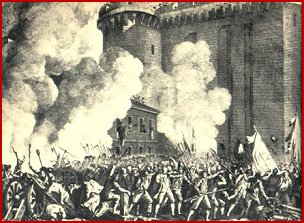
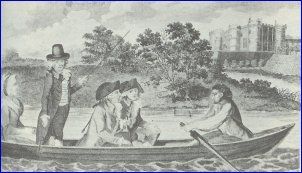
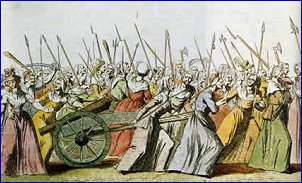
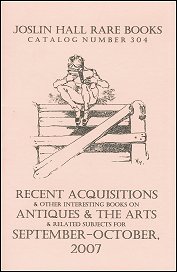 Our new catalog #304, "Recent Acquisitions & other interesting books, September-October, 2007" has now been
Our new catalog #304, "Recent Acquisitions & other interesting books, September-October, 2007" has now been